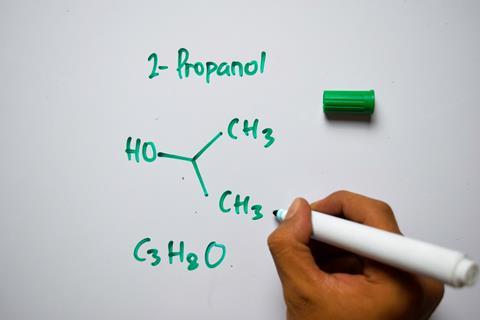Tips to clean whiteboard stains, accidental or otherwise …
Admit it: we’ve all drawn on a whiteboard with permanent marker. And the fact this phrase strikes fear into the hearts of most teachers rightly suggests some interesting chemistry is going on when you wield your pen.
Let’s begin with the whiteboard itself: why is it so easy to draw on? The key property is stain resistance. Early whiteboards were made of white-painted stainless steel, which was expensive. So, in the 1990s boards were coated with melamine resin. This is a mix of melamine (C3H6N6), an organic compound with fire-retardant properties (it releases nitrogen gas when burned, depriving the fire of oxygen), and formaldehyde (CH2O), one of the most widely-used resins in the world. As a thermosetting plastic, melamine resin is easily shaped onto a board. The whiteboard’s quality depends on the amount of resin applied: more makes the board better at resisting stains, increasing its longevity.
Making their mark

That’s the board covered; let’s move on to the pens. Permanent and dry erase markers – such as those you use on a whiteboard – have identical structures. They contain a polyester reservoir to store their ink and a felt tip that soaks it up and deposits it on the board. They have mostly the same ingredients, too: both contain water, along with preservatives, pigments and solvents. These components are responsible for the marks left when you write with the pen. Once the felt touches the surface, the exposed solvent (usually isopropanol) begins to evaporate, leaving only the sticky ink resin, which binds to the surface through van der Waals forces. Hence why both types of markers dry out and won’t work if you leave the caps off – the solvent has been exposed to the air.
The difference between permanent and dry erase markers comes down to the final ingredient: the polymers in the solution. While both pens work identically on paper or fabric because they are porous materials (the ink gets trapped in the pores), on a smooth surface – such as a whiteboard – the polymers change the final result. Permanent markers contain acrylic, which dries to create that telltale shiny finish and acts as a protective coating for the ink. Dry erase markers, however, use silicone, a lubricant that prevents the ink from bonding with the surface.
Dry erase ink’s water resistance means you can also have a little fun. Try drawing on the inner surface of a bowl with a whiteboard marker. Wait for it to dry, so all the solvent is gone, then fill the bowl with water. The water should cause the ink to break free from the surface of the bowl, and the hydrophobic nature of the silicone polymer will protect it from dispersing, causing the drawing to float.
Put this in context
Learn how development chemist, Mariam, makes inks with information about allergies and best before dates that can be safely printed on food and food packaging.
Get to the point
But what if the board gets stained? It’s important to remember that the polymers in both permanent and dry erase markers are water-resistant, so the best way to clean any stubborn smears on your board is to add a little squirt of alcohol. The most effective options contain at least one of the solvents used in the markers themselves, such as isopropanol. This is found in rubbing alcohol as well as nail varnish remover and should quickly disperse the ink before it evaporates, allowing you to rub it off. Since isopropanol is found in dry erase pens, drawing over a whiteboard stain and then rubbing with a cloth can also help remove it.
Getting ink out of clothes is far trickier as it soaks into the porous threads of the material. The best solution is to carefully dab the area with alcohol, then use paper to try to blot up the ink. Otherwise, the stain might spread.
Kit Chapman
Dip into this inky TikTok: ADD SHORT URL
Dip into this intriguing, inky TikTok to see the pens in action.














1 Reader's comment